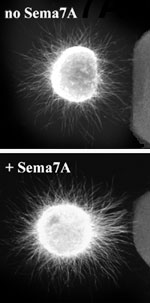

For decades, scientists have hunted for signals that guide nerve cells’ tentacle-like axons, hoping to understand how these cell tips reach out to distant targets. It’s knowledge that might one day help researchers learn how to rebuild nerves lost to spinal cord injuries or diseases like Huntington’s.
Now, a Johns Hopkins team studying a family of proteins best known for repelling axons and inhibiting their growth reports finding one member that unexpectedly promotes axon growth instead. In their experiments, rat nerves in the lab grew more and longer axons on the side nearest a source of this protein, called semaphorin-7a. Moreover, in mice without semaphorin-7a, axons of some odor-sensing nerve cells never reached their targets, the scientists report in the July 24 issue of Nature.
“I’ve been studying semaphorins for about a decade and didn’t expect to find any that stimulated axon growth, certainly not to the extent we saw in the lab and in mice,” says Alex Kolodkin, Ph.D., professor of neuroscience in The Johns Hopkins University School of Medicine’s Institute for Basic Biomedical Sciences. “Now we need to figure out how semaphorins balance their repulsive and attractive effects.”
Part of the answer to this paradox, Kolodkin says, is that semaphorin-7a interacts with different proteins than its relatives. In experiments with rat nerve cells involved in sensing odors, first author and postdoctoral fellow Jeroen Pasterkamp, Ph.D., found that semaphorin-7a spurs axon growth by hooking onto proteins called integrins, which are found on nerves and many other cell types.
Among their many roles, integrins (pronounced IN-teh-grins) help control cells’ interactions with their surroundings by capturing chemical signals and conveying the messages to cells’ internal machinery. Even though this is the first report to link semaphorins and integrins, both protein families are rapidly being recognized as major contributors to neurological function and disease, says Kolodkin.
“Because integrins are important throughout the body, targeting them to stimulate axon growth or re-growth in a particular area of the brain or spinal cord presents many problems,” notes Pasterkamp. “Our next steps are to find out exactly how semaphorin-7a’s message is passed along inside the nerve, which will hopefully reveal a useful, specific target for promoting axon growth following nerve injury or degeneration.”
As the researchers learn more of the specifics about how semaphorin-7a differs from its relatives, they also hope to redraw their picture of how semaphorins as a family affect nerve development throughout life, they say.












